Key points
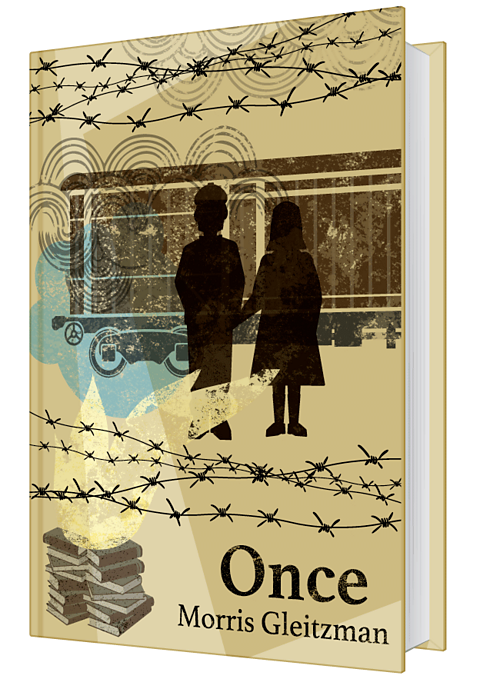
Once was written by Morris Gleitzman in 2005.
It is a work of fiction but was inspired by historic events, such as the HolocaustThe Holocaust was the murder of approximately six million Jewish men, women and children by Nazi Germany and its collaborators during World War Two..
The main character is a young JewishAn adjective to describe someone or something related to the religion of Judaism. boy called Felix. He has been living in a Polish orphanage for over three years when men in armbands arrive and start burning books.
Felix goes on the run in search of his parents, but soon learns that Poland in 1942 is unsafe for a young Jewish boy.

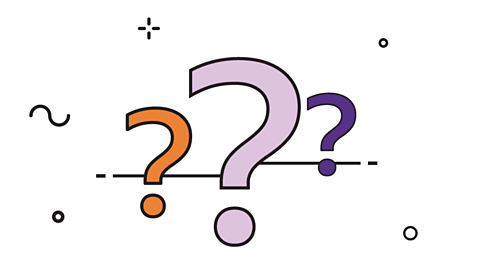
Did you know?
Gleitzman dedicated this novel to:
"all the children whose stories have never been told."
What do you think this dedication means?
Once tells the story of a young Jewish boy who lived through the Holocaust. The Holocaust was the murder of approximately six million Jewish men, women and children by Nazi Germany and its collaborators during World War Two.
Most children who experienced the Holocaust did not survive. This novel is a way to remember them and find out more about how their lives might have been.
Video
Watch the video below to learn about the plot, characters and themes in Once by Morris Gleitzman.
Once there was a young Jewish boy called Felix, who ran away from an orphanage in the mountains and set off on a journey insearch of his parents.
Once by Morris Gleitzman is a novel set in Poland during World War 2. It is told through the innocent eyes of 10-year-old Felix, who is living through the Holocaust.
Soon after he leaves the orphanage, Felix rescues an orphaned girl, Zelda, and brings her along on his journey. Before long, the two children find themselves in a Jewish ghetto in the city. They are rescued by a brave man, Barney, who takes them to a hidden cellar, full of other rescued children. But in the end even Barney cannot save them from the Nazis and they are forced onto a train heading to a death camp.
However, when Felix and Zelda get a chance to escape, they grab it with both hands.
"Everybody deserves to have something good in their life at least once."
Felix, the narrator, is an optimistic boy who loves books and uses storytelling to comfort himself and others. At the beginning of the novel, Felix seems naive to the realities of the war. But even as the truth gradually reveals itself to him, he remains kind and concerned for others.
Zelda is the young girl rescued by Felix after her parents are killed. She is resilient and brave. They develop a strong relationship like a big brother and little sister.
Barney is a Jewish dentist who selflessly risks his life to try and save the children. He represents hope and kindness.
Once is told through a first-person narrator – we see everything from Felix's perspective. Because we know more about World War 2 and the Holocaust than Felix, we can see the danger he is in, before he does. This is called dramatic irony when the reader knows more than the characters.
The power of storytelling is a theme throughout the novel. Felix uses stories to inspire and give strength and hope to himself andothers.
Once by Morris Gleitzman is an inspirational story, showing the power of love and hope in a very dark period in history.

Did you know?
As research for the novel, Gleitzman read lots of books about and by young people in the HolocaustThe Holocaust was the murder of approximately six million Jewish men, women and children by Nazi Germany and its collaborators during World War Two..
One of these books was The Diary of a Young Girl by Anne Frank.

Who was Anne Frank?
Anne Frank was a Jewish girl who hid from the Nazis for more than two years during World War Two. She was eventually discovered and taken to a concentration camp where she died. Her father found, read and published her diary. It has since been translated into more than 70 languages.
Plot
Felix is a ten-year-old JewishAn adjective to describe someone or something related to the religion of Judaism. boy. He lives in a Catholic orphanage in German-occupied Poland during World War Two.
Three years ago, his parents left him at the orphanage to keep him safe from the NaziAn abbreviation for the National Socialist German Workers’ Party (NSDAP) and its members. The Nazi Party's main ideas were based on racism, including antisemitism, and opposition towards democracy and other political systems. who were murdering Jewish people. Felix thinks his parents will come back for him.
One day, Nazis arrive at the orphanage and start burning books. Felix is worried about his parents who run a book shop and leaves to try and find them.Felix goes home but his parents are not there. On his journey, he finds Zelda – a young girl whose parents are dead and whose house has burned down. Felix takes her with him and tells her stories to calm her down.
The two children are forced to march to the city. They are rescued by a man named Barney who hides them in a cellar with other rescued children. Barney is a dentist. He asks Felix to tell his patients stories to distract them while he is fixing their teeth.
The Nazis discover their hiding place and force Barney and the children onto a train heading towards an extermination camp. Zelda is not Jewish, so Felix and Barney try to get her to go with the Nazis to save her life. She refuses.
On the train, Felix kicks a hole through some rotten wood. Felix and Zelda jump out and survive.
Barney stays on the train with the other children who are too afraid to try to run away.
Activity
Characters

Felix
Felix is a ten-year-old JewishAn adjective to describe someone or something related to the religion of Judaism. boy living in an orphanage in Poland during World War Two.
He is determined to find his parents, but does not understand of the dangers of NaziAn abbreviation for the National Socialist German Workers’ Party (NSDAP) and its members. The Nazi Party's main ideas were based on racism, including antisemitism, and opposition towards democracy and other political systems. occupation.
He is brave, resilientAble to recover quickly when something difficult has happened. and an imaginative storyteller.

Zelda
Zelda is about six years old and can be stubborn.
The Polish resistancePolish people who fought against the Nazis in German-occupied Poland. killed her parents because they were Nazi collaborators, so she is also an orphan.
Zelda likes listening to Felix's stories.

Barney
Barney is a JewishAn adjective to describe someone or something related to the religion of Judaism. dentist working and living in the ghetto in the city.
He rescues Felix and Zelda and takes them to live in a basement where he is keeping other Jewish children safe.
Barney is a brave and caring character who would do anything to protect the children.

Mother Minka
Mother Minka is the head nun at the orphanage. She shelters Felix from the NaziAn abbreviation for the National Socialist German Workers’ Party (NSDAP) and its members. The Nazi Party's main ideas were based on racism, including antisemitism, and opposition towards democracy and other political systems.. She is good-hearted and brave.
Dodie
Dodie is Felix’s best friend at the orphanage. His real name is Dodek. Felix protects him and other children from the orphanage bullies.
Activity
Themes
Themes are the main ideas that appear repeatedly in a novel. Some of the important themes in Once are:
- Hope
- Friendship
- Storytelling
Hope

Throughout the novel, hope is shown to be important to survival – being able to keep going through horrific experiences.
At the beginning of the novel, Felix’s hopefulness and naivetyInnocence or lack of experience sets him on a dangerous and unrealistic path. However, after finding out the truth about Hitler and the Nazi persecutionTreating people poorly based on their political beliefs, race, religion or sexuality. of the Jews, Felix realises he still needs hope to give him courage and strength.
Hope inspires Felix and the other characters in the novel to try to reach safety and find a better future.

Friendship
Friendship is at the heart of the novel.
From trying to get Dodie the first turn in the bath at the orphanage, to protecting Zelda at the risk of his own life, Felix is shown to be a good friend.
Friendship and caring for others is shown to be part of what makes a good person.
Storytelling

In Once, storytelling has power. Felix’s stories help him to survive, protect others and provide hope for the future.
His stories create strong bonds between the characters and even inspire the children to tell their own traumatic stories.

Activity
Language
Writers choose words and phrases carefully when they write. Readers can look closely at texts to think about how and why the writer made these choices.

First-person narrative
Once is told from Felix’s point of view, using a first person narrativeWhen a character within the story is telling the story. The main personal pronouns used are I, my, me, we. voice. This means that the story is told from Felix's perspective using the pronoun "I".
The author has carefully chosen the language that Felix uses to reveal his innocent, child’s view of the world. For example, when he finds a whole carrot in his soup, Felix believes it is a sign that his parents are coming to take him home.
Another example is when he prays to "God, Jesus, the Virgin Mary, the Pope and Adolf Hitler" because he doesn’t know who Hitler is but understands he is a powerful person.

Is this sentence written in the first-person? How do you know?
"Once I was living in an orphanage in the mountains and I shouldn’t have been and I almost caused a riot."
Yes. This sentence is written in the first person because it uses the pronoun "I".
Dramatic irony
Often the reader understands more than Felix does about what is going on. This is called dramatic ironyWhen the reader knows more than the character about what is going on in the story..
For example, when a soldier tries to shoot Felix, he doesn’t realise what is happening and thinks the soldier is playing a "little trick". He even feels sorry for the "poor soldier" because his trick didn't work. The reader knows the real danger Felix is in though and fears for his safety.
What does dramatic irony mean?
Dramatic irony is when the reader knows more than the character about what is going on in the story.
Structure
Structure refers to how written text is organised – the way the story is ordered and shaped.
Repetition
Every chapter begins with the word "once" and an overview of the story Felix will tell us in that chapter.
The word "once" is also used to open and close the novel:
"Once I was living in an orphanage in the mountains…"
"Barney said everybody deserves to have something good in their life at least once. I have. More than once."
The repetition reminds the reader that this is a story that happened in the past, but that it's also an important story that deserves to be remembered and passed on.
Motifs
The author includes lots of repeated images (which are known as motifA motif is an idea that occurs repeatedly through a piece of writing.) such as:
- The carrot
- Felix’s notebook
- The story about a boy called William who lived in a castle.
When authors repeat things it is often because they symbolise something important. The motifs in Once remind us of the importance of hope and of telling stories to help us understand what is happening in the world around us.

Cliffhanger ending
The book ends with a CliffhangerA cliffhanger is when a story or chapter ends dramatically without revealing exactly what happens to the characters. The reader is left guessing. after Felix and Zelda jump from the train. Felix says:
"I don’t know what the rest of my story will be."
This creates uncertainty for the reader because it isn't clear what will happen next. All that is certain is that Felix and Zelda are still in a lot of danger.

Activity
Context
To understand Once, it’s important to know about the historical time period in which the story is set. Gleitzman wanted to write this story partly because he had JewishAn adjective to describe someone or something related to the religion of Judaism. relatives who had been in Poland during World War Two.
Adolf Hitler was the leader of a political party called the NaziAn abbreviation for the National Socialist German Workers’ Party (NSDAP) and its members. The Nazi Party's main ideas were based on racism, including antisemitism, and opposition towards democracy and other political systems. who ruled Germany from 1933 to 1945. World War Two started when Germany, led by Adolf Hitler, invaded Poland in 1939. Hitler and the Nazi party were antisemiticHolding hostile or prejudiced views against Jewish people..
In 1941, the Nazis and their collaborators intended to murder every Jew in all the countries they controlled during the Second World War. They put Jews onto trains which took them to extermination camps in Nazi-occupied Poland. Gas chambers were built at these camps, where people were murdered. The camps also had crematoriums to burn the bodies, reducing them to ashes. In other places, the Nazis and their collaborators built labour and concentration camps where prisoners were worked to death or died due to the appalling conditions.
the HolocaustThe Holocaust was the murder of approximately six million Jewish men, women and children by Nazi Germany and its collaborators during World War Two. is the name given to the murder of six million Jews by the Nazis and their collaborators during the Second World War. Other victims of Nazi persecution included Roma and Sinti people, Soviet Prisoners of War, political prisoners, Jehovah’s Witnesses, disabled people, Black people, homosexuals and others.
The slideshow below shows images from one of the extermination camps, called Auschwitz.
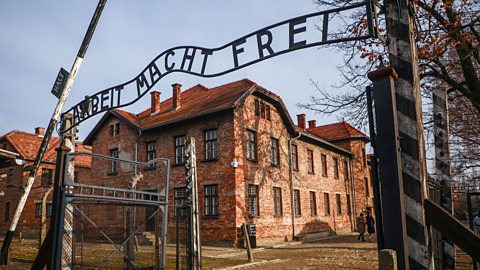
Image caption, The entrance to Auschwitz. The sign over the gate reads "Arbeit macht frei" which means "Work sets you free"
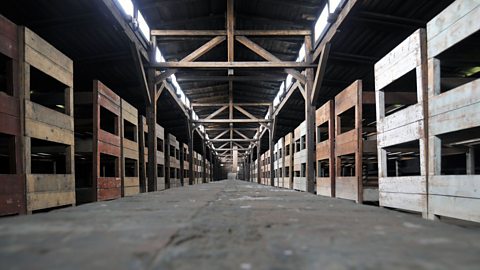
Image caption, Wooden bunks in a dormitory at Auschwitz

Image caption, Roll call square at Auschwitz, where prisoners were counted every morning and evening
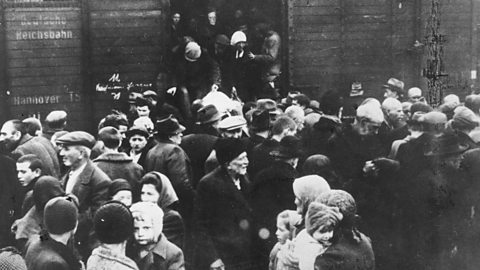
Image caption, Jewish people from Hungary arriving at Auschwitz, June 1944
1 of 4
The events in Once take place when Poland was occupied by the Nazis. This is why Felix, who is Jewish, is hiding in a Catholic orphanage.
At first, he does not understand who Hitler is or what is happening in Poland. He is shocked to find out that Hitler, "the most important man in Poland", hates the Jewish people and is trying to kill them all.
You can find out more about this period in history by looking at the KS3 guide on The Holocaust, 1939 - 1945.
Test your knowledge
GCSE exam dates 2025
Find out everything you need to know about the 2025 GCSE exams including dates, timetables and changes to exams to get your revision in shape.

More on Literature
Find out more by working through a topic
- count13 of 18
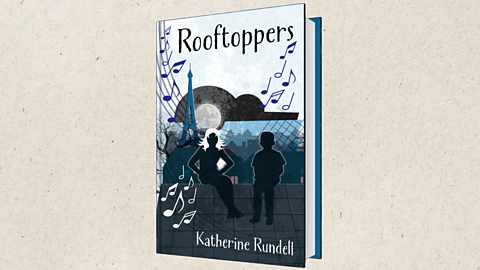
- count14 of 18
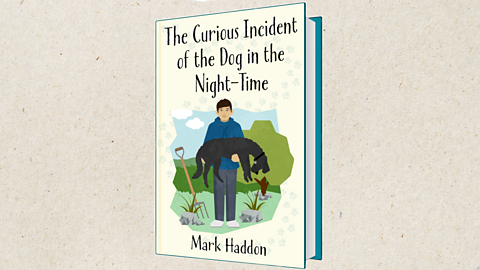
- count15 of 18
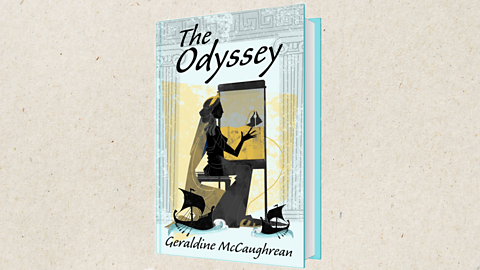
- count16 of 18
